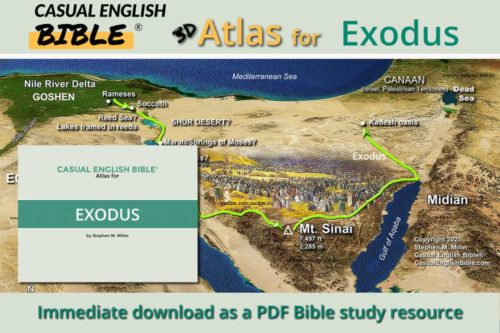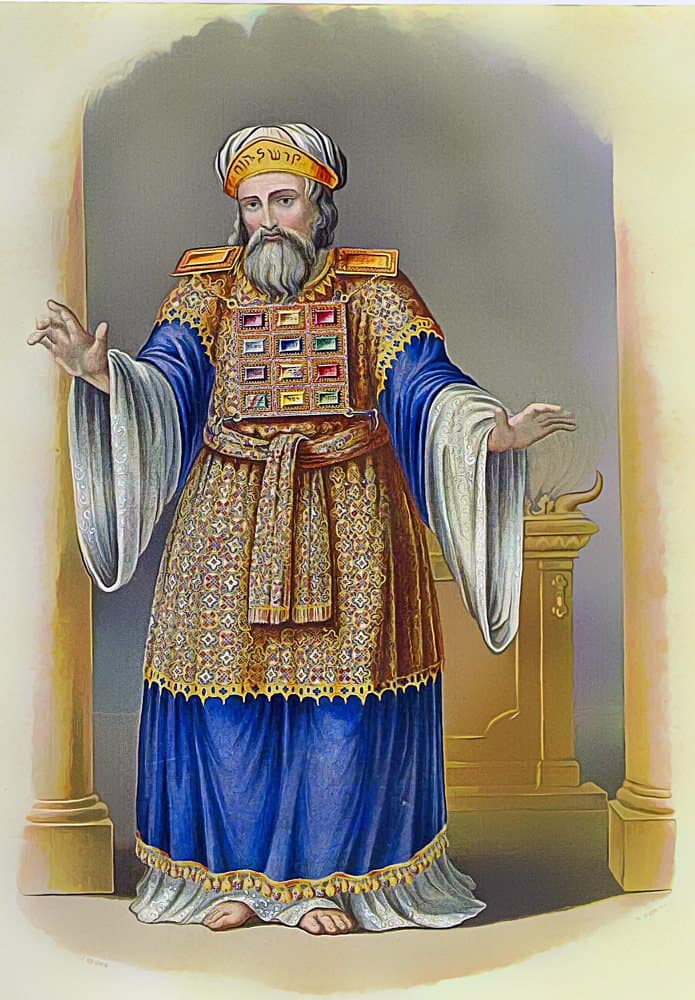Exodus 28
Priestly fashions
Clothes fit for a priest
1The LORD told Moses, "I want you to call a meeting with your brother Aaron and his four sons Nadab, Abihu, Eleazar, and Ithamar. I want them to work for me as priests. 2You'll need to dress them in clothes that project dignity and are appropriate for this sacred assignment. 3Tell all the people gifted in the art of making clothes— a gift I gave them—that I want them to make Aaron's clothing worthy of someone I choose as my high priest. 4Here are the clothes I want the artisans to make him: a vest [1] to cover his chest, an apron to wear at the waist, a robe, a checkered tunic as a shirt, a turban for the head, and a sash as a belt around his waist. Artisans should make these sacred clothes for Aaron and for his sons, who will work for me as my priests.5Give the clothing makers the material they need: gold, fine linen, and fabric in the colors of blue and purple and crimson. 6Skilled artisans should make the apron out of fine linen and gold. Gifted embroiderers should decorate it in the colors of blue, purple, and crimson 7Add shoulder straps for the apron. 8Give it a belt for the waist. Make the belt of fine linen and gold, and then embroider it with blue, purple, and crimson.
Jeweled apron for high priest
9Engrave two onyx [2] stones with the names of Israel's 12 tribes. [3] 10Engrave these names in the order that each tribal leader was born. Put six names on one stone and six on the other. 11Engrave these names on the two stones, just as a jeweler might do. Then give each stone a delicately crafted gold setting. [11]12Mount the stones onto the apron’s shoulder straps. While Aaron serves the LORD, he’ll carry these engraved names as a constant reminder of the people of Israel. 13Make delicately crafted gold settings. 14Make two chains of pure gold, with braided cords. Add them to the gold settings of the stones for the shoulder straps of the apron.
Chest Shield of Law and Order
15Assign a skilled embroiderer to make the vest, the Chest Shield of Law and Order. [5] Use all the skill you used earlier, when you made the apron. Use gold, along with fine linen and fabric colored in blue, purple, and crimson. 16Make the front of the vest into a nine-inch (23 cm) square, with the fabric folded over to form two layers, with a pocket in between. 17Mount a dozen gem stones onto it, designed in four rows.First row: the red carnelian, the olive-green peridot, [6] emerald. 18Second row: turquoise, sapphire, and emerald. [7] 19Third row: jacinth, agate, and amethyst. [8] 20Fourth row: beryl, onyx, and jasper.
21Engrave the name of the 12 tribes of Israel onto the 12 gemstones. One name per stone. Make each stone look like an engraved seal. [9] 22For the top of the vest, make two chains of braided gold. 23Add two gold rings at the top corners of the vest. 24Attach one end of the braided gold chains to the rings, one chain per ring. 25Attach the other end of the gold chains to the shoulder straps of the apron. 26Attach two more gold rings near the bottom of the vest, by the apron. 27Attach another two gold rings on the apron, at the bottom of the shoulder straps, above the delicately woven sash belt.
28To keep the vest from hanging loose, tie it to the apron. Use blue cords to connect the bottom rings of the vest to the lower rings on the apron. 29When Aaron wears this vest, the Chest Shield of Law and Order, he is carrying the names of Israel over his heart. When he steps into the Most Sacred Room of the tent worship center and stands before the LORD, it will remind him of the people. 30Make a pocket in the vest for two objects called Lights and Perfection. [10] Aaron will carry these over his heart when he goes into the Most Sacred Room to stand before the LORD, and when people ask him for the LORD’s decision about something.
Putting bells on the high priest
31Make the high priest a blue robe to wear under the apron. 32Make it one piece, with a hole in the middle of the fabric. This is for his head. Reinforce the cut of the opening with a woven collar, as distinct as the collar of a warrior’s coat of mail. This is to keep the fabric from ripping.33Decorate the hem of the robe with embroidered pomegranates of blue, purple, and crimson. Between each pomegranate, add a golden bell that rings 34Keep these items in strict order. Start with a golden bell and a pomegranate, then follow with another golden bell and a pomegranate. Keep that pattern all the way around the hem. 35Aaron will wear this robe when he’s working. The bells will ring when he goes in and out of the worship center. He needs to wear this if he wants to stay alive. [11]
36Engrave a strip of gold with these words: Devoted to the LORD. 37Use a blue cord to attach this gold medallion to the front of Aaron’s turban. 38Aaron needs to wear this on the front of his turban. When he does, he takes on the guilt of the people of Israel whenever they bring me their sacred offerings. Aaron needs to wear this all the time. When he does, I will forgive the people and accept them. 39Use only fine linen to make the turban and tunic shirt. Decorate the sash belt with embroidery.
Dressing Aaron’s sons
40Dress Aaron’s sons in beautiful and dignified clothing. Make them tunic shirts [12] and sash belts. Give them hats, as well. The clothes should be glorious. 41When Aaron and his sons put on these clothes, anoint [13] these men with olive oil and authorize [14] them as my priests. 42One more thing. Make underwear for them, too. Underwear should reach from the waist to the thighs. 43Aaron and his sons need to wear this style of clothing whenever they step foot into the courtyard of the worship center and in the Sacred Room, where they perform their duties every day. If they do this, they won’t have to die for disobeying me. This law that I’ve made isn’t temporary. It’s for Aaron and all of his descendants.”Footnotes
“Apron” is more literally ephod. Scholars debate exactly what that looked like. Some describe it as a skirt or a shift-like garment that covered the body from about the waist to the mid-thigh. Priests used what was described as an ephod to store the sword of Goliath, after David killed this Philistine champion warrior (1 Samuel 23:9).
Onyx stones have colorful layered bands ranging in color from black to white and almost every color in between. Black is the most popular color to buy today. But most of those stones are artificially colored.
Genesis 49 says a dozen children and grandchildren of Jacob “became the founding fathers of Israel’s 12 tribes” (49:28).
More literally, “filigree settings.”
More literally, the “Decision Chestpiece.” The descriptive word in Hebrew is mispat. It can mean a wide variety of words, including: justice, judgment, law, court, rights, and decisions. We need context clues to pick the right word. The general idea, however, seems to suggest the vest, which the high priest wears over his heart, represents his authority to deliver God’s messages and judgments to the people.
Also known as chrysolite.
This is a guess. The Hebrew word is yahlom. What that means is unclear. Pick a gem. Different Bible translations offer different lists of stones. That’s because some of the Hebrew names remain a mystery. But the context of this list suggests that every stone is a gem, and a symbol of great value.
This is another guess. The Hebrew word is ahlama. What that means is unclear.
People used engraved stones to stamp a symbol onto a plug of moist clay or melted wax to seal closed a private letter or an official document.
These were two objects never described in the Bible. They might have been stones, marked or colored in different ways. The high priest used them to answer questions with a “yes” or “no” or “wait.” It might have worked a bit like tossing two coins in the air and seeing how they land. Two heads for “yes.” Two tails for “no.” One of each for “wait.” It might seem foolish to make an important decision that way, such as whether to go to war. But the people of Israel seemed to believe that God controlled the objects the priests used. That doesn’t mean the Bible endorses making decisions that way today. As in, two heads up for a four-wheeler or two tails up for retirement savings. The Hebrew names are Urim and Thummim, described as meaning “lights” and “perfection.”
The writer doesn’t say why the high priest has to wear a robe that rings. A ringing robe sounds irritating, whether you have to wear it or just hear it. But it apparently became one of the sounds of worship. And worshiping the LORD involved other senses as well. The touch of an animal offered in sacrifice. The smell of the meat burning on the altar. The taste of the meat in sacrifices that allowed worshipers to share some of the meat in a meal with family and friends.
The standard priests also got to wear a tunic as part of their uniform, but apparently not checkered ones like the High Priest got.
Pouring olive oil on people was an ancient Jewish tradition known as anointing. It was a way of showing people that they had a connection with God. A prophet named Samuel anointed young David as the future king of Israel. “Samuel poured the olive oil out of the horn and onto David’s head while his older brothers watched. The LORD’s Spirit poured into David and stayed with him for the rest of his life” (1 Samuel 16:13). Christians picked up that tradition and used it in a ritual that included praying for the sick and placing hands on them. “Do you have any sick people there? If so, ask the church leaders to pray over them and to anoint them with oil. Do this in the name of the Lord, invoking the Lord’s authority” (James 5:14).
Also translated “ordain,” as in “an ordained minister.”
Discussion Questions
- Sorry, there are currently no questions for this chapter.







